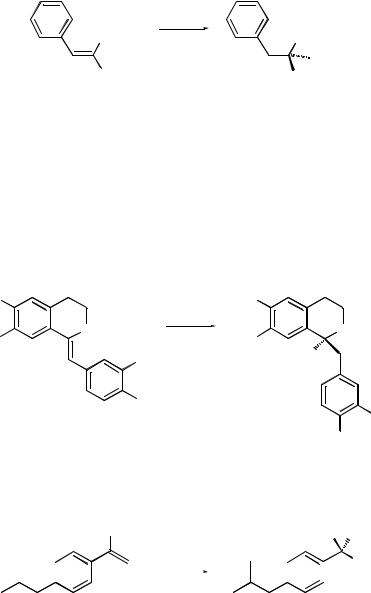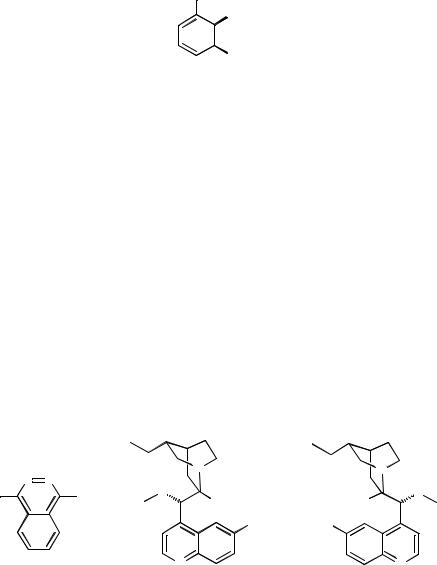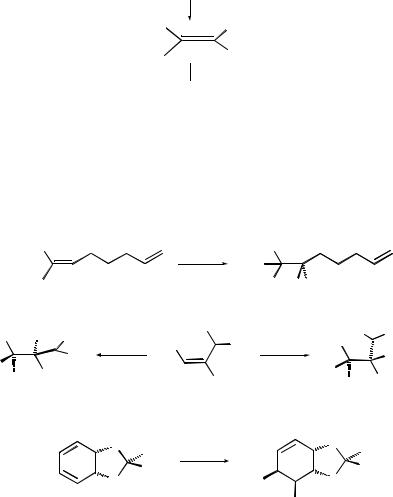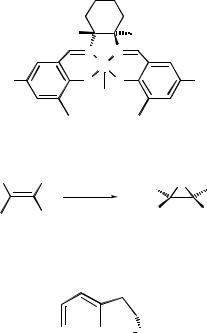

12 |
hydrolysis, oxidation and reduction |
can be employed often with the production of secondary alcohols with high ee. For example iso-propylmethyl ketone and tert-butylmethyl ketone are good substrates giving secondary alcohols with > 91 % ee[41]. Alternatively oxazaphosphinamides* and hydroxysulfoximines* have been used to control the stereochemistry of the reduction of simple ketones by borane.
Brook has effectively modified a procedure (introduced by Hosomi) which employs a trialkoxysilane as the stoichiometric reducing agent which, in the presence of amino acid anions reduces aryl alkyl ketones or diaryl ketones to the corresponding (S)-secondary alcohols, albeit in modest ee (generally 25±40 %)*.
Much the same situation pertains to the asymmetric reduction of diketones and ketoesters. Thus, some years ago, a yeast reduction of the diketone (12) formed a key step in the preparation of important steroids (Scheme 9). Work in
|
O |
|
HO |
H |
|
|
|
||
Me |
i |
Me |
|
Steps |
|
|
|
||
R |
|
R |
|
steroids |
|
|
|
||
|
O |
|
O |
|
|
(12) |
|
|
|
R=
MeO
Scheme 9: Reagents and conditions: i) Saccharomyces sp., H2O.
this area has continued, with closely related 2,2-disubstituted cyclopentane-1,3- diones[42] and other diketones. Indeed the diol (13) has been manufactured on a
large scale by reduction of the corresponding hydroxydione using bakers' yeast[43]. The same microorganism is used in the reduction of a classical sub-
strate, ethyl-3-oxobutanoate (aka ethyl acetoacetate), to give (S)-hydroxyester in a process optimised by Seebach*[44]. (Interestingly it has recently been shown that anaerobically grown bakers' yeast yields the corresponding (R)-alcohols with impressive optical purity [96±98 % ee].)[45]
Me |
OH |
O |
H |
|
|
|
OH |
(13)

the integration of biotransformations into catalyst |
13 |
However, as for simpler carbonyl systems, organometallic catalysts offer a powerful alternative to biotransformations. By way of comparison methyl- 3-oxobutanoate is reduced to the (R)-3-hydroxyester (> 99 % ee) quantitatively using (R)-BiNAP±RuCl2 under 100 atmospheres of hydrogen[46]. A variation of this reaction using immobilized catalyst yields the chiral alcohol (92 % ee) at roughly the same rate[47], while GeneÃt's modification of the original procedure, preparing the catalyst in situ and employing a hydrogen pressure of one atmosphere, allows the reaction to be performed without special apparatus*. Note that other ligands have been employed for the ruthenium catalysed reduction of b- ketoesters. For example, a new diphosphine (BisP*), (‡)-ephedrine and other amino alcohols (for asymmetric transfer hydrogenation of arylketones and b- ketoesters*) are described later, in the relevant experimental section.
Reduction of diketones such as pentane-2,4-dione using (R)-BiNAP±RuCl2 under hydrogen (75±100 atm) gives the corresponding diol, in this case (R),(R)-
2,4-pentanediol with an excellent diastereomer ratio (98 %) and optical purity (>99 %)[48].
When the dione has different terminal groups the Ru±BiNAP reduction can be selective towards one carbonyl group (Scheme 10)[49].
O |
O |
OH |
O |
|
|
i |
+ 2% diol |
Me |
|
Me |
98 % ee
89 % yield
Scheme 10: Reagents and conditions: i) H2 (48 atm) [(R-BiNAP)RuCl(m-Cl)3] [NH2 (C2H5)2], MeOH, 50 8C.
1.2.2REDUCTION OF ALKENES
Very few enzyme-catalysed reactions involving the reduction of alkenes have achieved any degree of recognition in synthetic organic chemistry. Indeed the only transformation of note involves the reduction of a, b-unsaturated aldehydes and ketones. For example, bakers' yeast reduction of (Z)-2-bromo- 3-phenylprop-2-enal yields (S)-2-bromo-3-phenylpropanol in practically
quantitative yield (99 % ee) when a resin is employed to control substrate concentration[50]. Similarly (Z)-3-bromo-4-phenylbut-3-en-2-one yields 2(S), 3(S)-3-
bromo-4-phenylbutan-2-ol (80 % yield, >95 % ee)[51]. Carbon±carbon double bond reductases can be isolated; one such enzyme from bakers' yeast catalyses the reduction of enones of the type ArÿCH ˆ C(CH3)ÿCOCH3 to the corres-
ponding (S)-ketones in almost quantitative yields and very high enantiomeric excesses[52].

14 |
hydrolysis, oxidation and reduction |
One facet of the whole cell work that draws attention is the sometimes profitable operation of a cascade of reactions in the multi-enzyme portfolio of the microorganism. For instance (Scheme 11), the allylic alcohol (14) is reduced to the corresponding saturated compound in high yield and optical purity (though in a slow reaction) via the intermediacy of the corresponding enal and (S)-2-benzyloxymethylpropanal[53].
|
|
|
|
i |
Me |
H |
|
PhCH2O |
|
|
OH |
|
|
||
|
|
|
PhCH |
O |
OH |
||
|
|
|
|||||
|
|
|
|
2 |
|
|
|
|
14 |
|
|
|
>98 % ee |
||
|
|
|
|
|
|
80 % yield |
|
Scheme 11: Reagents and conditions: i) Bakers' yeast, 30 8C, 14 days.
Historically the biotransformations of cyclic enones have been important, not least Leuenberger's transformation of the appropriate cyclohexenedione into the saturated ketone (15), a precursor for tocopherol[54]. Similarly 2- methylcyclohex-2-enone is reduced by the microorganism Yamadazyma farinosa (also known as Pichia farinosa) to give a mixture of saturated alcohols and ketone; pyridinium chlorochromate oxidation of this mixture afforded 3(R)- methylcyclohexanone (95 % ee) in 67 % yield[55].
O
H


 Me
Me
O
(15)
In the area of organometallic chemistry enantioselective hydrogenation of prochiral functionalised alkenes using chiral phosphine complexes of rhodium or ruthenium as catalysts has been extensively researched and, widely reported; the early work has been reviewed[56]. The first systems investigated involved organorhodium species particularly for the reduction of dehydroamino acid derivatives (Scheme 12)[57] but the emphasis shifted, some twenty years ago, to organoruthenium complexes, for example, the ruthenium±BiNAP system of Noyori[58]. The latter catalyst was found to be capable of catalysing the reduction of a wider range of substrates: for example, promoting the reduction of geraniol to (R)-citronellol (99 % ee) under hydrogen (100 atm) using methanol as the solvent and in the synthesis of benzomorphans and morphinans[59].

the integration of biotransformations into catalyst |
15 |
|
|
i |
|
NHCOPh |
NHCOPh |
|
|
H |
|
CO2H |
CO2H |
|
|
96% ee |
|
Scheme 12: Reagents and conditions: i) [(BINAP)Rh(MeOH)2]‡[ClO4]ÿ cat., 1 atm H2, MeOH.
The broad range of alkenes undergoing asymmetric hydrogenation using ruthenium-based systems as catalysts has attracted the attention of chemists engaged in the synthesis of chiral biologically active natural products (Scheme 13)[60] and other pharmaceuticals (Scheme 14)[61]. a, b-Unsaturated phosphoric acids and esters have also proved to be suitable substrates for Ru(II)-catalysed asymmetric hydrogenation*[62].
MeO |
|
MeO |
NCOMe |
|
i |
|
NCOMe |
|
MeO |
|
MeO |
|
OMe |
H |
|
|
OMe
OMe
OMe
99.5 % ee
Scheme 13: Reagents and conditions: i) Ru±BiNAP (1 mol %), H2 (4 atm) methylene chloride in MeOH.
|
|
|
|
CO2H |
|
|
|
HO2C |
H |
|||
|
|
|
|
|
|
i |
|
|
|
|
|
Me |
|
|
|
|
|
|
|
|
|
|
|||
|
|
|
|
|
|
|
|
|
|
|
|
|
|
|
|
|
|
|
|
|
|
|
|
|
|
|
|
|
|
|
|
|
|
(S )-ibuprofen |
|
|||
|
|
|
|
|
|
|
|
97 % ee |
|
|||
Scheme 14: Reagents and conditions: i) |
Ru(S)±tetrahydroBiNAP |
(0.5 mol%), |
||||||||||
H2 (100 atm), MeOH, 8 h. |
|
|
|
|
|
|
||||||
Since these early days different ligands for rhodium complexes have been invented that more efficiently catalyse asymmetric reduction of a range of

16 |
hydrolysis, oxidation and reduction |
dehydroamino acids. One of the more popular ligands for general usage has been Burk's DuPHOS (Scheme 13)*[63].
|
|
Me |
P |
Me |
CO2Me |
|
|
|
|
(CH3CH2)2CH |
CO2Me |
|
|
|
i |
|
|
||
NHCOMe |
MeCONH |
H |
|
|
|
|
Me |
P |
Me |
|
|
|
(S,S )- MeDuPHOS
Scheme 15: Reagents and conditions: i) Rh±DuPHOS (0.2 mol%), H2 (6 atm), benzene.
This strategy also gives access to a variety of non-natural a-amino acids. Furthermore, rhodium±DuPHOS complexes catalyse the asymmetric reduction
of enol esters of the type PhCH ˆ CH ÿ C(OCOCH3) ˆ CH2 to give (R)-2- acetoxy-4-phenylbut-3-ene (94 % ee)[64].
The use of chiral rhodium complexes fashioned from ferrocene derivatives has gained in popularity significantly in recent years*[65].
The portfolio of bisphosphine ligands for rhodium-catalysed asymmetric hydrogenation of dehydroamino acids is now becoming complemented by a set of bisphosphinite ligands*, typified by Chan's spirOP (16)[66] and carbohy- drate-based systems invented by Selke and RajanBabu[67]. The attraction of the use of the bisphosphinites lies in the simplicity of the preparation of the ligands (by reacting optically active diols with chlorophosphines in the presence of base)[68]. A remarkably selective one-pot procedure for sequential alkene and
carbonyl reduction using chiral rhodium and ruthenium catalysts allows the preparation of amino alcohols with up to 95 % ee*[69].
|
R |
Me |
COMe |
|
|
|
|
||
|
Me |
|
O |
Ph |
|
|
|
N |
|
|
OPPh2 |
|
|
|
|
OPPh2 |
|
|
|
|
O |
|
|
|
(16) |
(17) R = H |
|
(19) |
|
|
(18) R = OH |
|
|
|
the integration of biotransformations into catalyst |
17 |
1.3OXIDATIVE TRANSFORMATIONS
In this important area of synthetic chemistry honours are more equally shared between biocatalysis and other forms of catalysts, the latter being made up, almost invariably, of man-made organometallic species. Thus biotransformations are the preferred pathway for the hydroxylation of aliphatic, alicyclic, aromatic and heterocyclic compounds, particularly at positions remote from pre-existing functionality[70]. In contrast organometallic species are the catalysts of choice to convert alkenes into epoxides and diols. Both natural and non-natural catalysts are adept at the conversion of some sulfides into the corresponding sulfoxides and in performing stereoselective Baeyer±Villiger oxidations. Some of the details are provided hereunder.
The ability of microorganisms to convert alicyclic compounds into related alcohols by regioand stereo-controlled hydroxylation at positions distant from regioand stereo-directing functional groups was used extensively in the modification of steroids[71]. In a classical example the hydroxylation of progesterone (17) with Rhizopus sp. or Aspergillus sp. furnished the oxidized product (18), forming a key step in a highly efficient pathway to the anti-inflammatory steroids such as Betnovate[72]. Other complex alicyclic natural products and closely related compounds (e.g. taxanes)[73] have been selectively hydroxylated using some of the more easily handled organisms such as Mucor sp., Absidia sp. and Cunninghamella sp.
The selective monohydroxylation of heterocyclic compounds such as piperidine derivatives[74] and the g-lactam (19)[75] have been studied. It is also been
shown that hydroxylation of phenylcyclohexane can be effected using cytochrome P450 and the regioselectivity of hydroxylation can be altered by sitedirected mutagenesis of the enzyme[76].
While undoubtedly powerful methodology, the major problem concerning enzyme-catalysed hydroxylation of alicyclic and saturated heterocyclic compounds is the unpredictability of the site of hydroxylation. Not surprisingly a start has been made to control the regioselectivity of microbial hydroxylation by using an easily-introduced and easily-removed directing group which, if such a suitable auxiliary could be found, would very conveniently promote hydroxylation at a set distance from the temporary appendage[77].
The hydroxylation of aromatic compounds using microorganisms is more predictable and a number of processes have been adapted to large scale, for example the preparation of 6-hydroxynicotinic acid[78] and (R)-2-(4-hydroxy- phenoxy)propanoic acid[79], important intermediates to pesticides and herbicides respectively.
The biotransformation that has caught the imagination of many synthetic organic chemists involves the conversion of benzene and simple derivatives (toluene, chlorobenzene, etc.) into cyclohexadienediols (20) using a recombinant microorganism E. coli JM109. The one step oxidation, via reduction of the

18 |
hydrolysis, oxidation and reduction |
R
OH
OH
R = H, Me, Cl
(20)
corresponding dioxetane, is impossible to emulate using any other simple process. Cyclohexa-3,5-diene-1,2-diol produced in this way was used as a starting material in the polymer industry. The dienediol products from toluene and chlorobenzene are even more interesting being essentially optically pure and, for this reason, they have been used to prepare optically active morphinans, carbohydrate analogues, pancratistatin and cis-chrysanthemic acid, generally by selective transformations involving the two alkene bonds[80].
However, for the dihydroxylation of alkenes the microbiological method is not so effective and the biocatalytic methodology pales into insignificance compared with the powerful chemical technique introduced by Sharpless.
Also fifteen years of painstaking work and the gradual improvement of the system, the Sharpless team announced that asymmetric dihydroxylation (AD) of nearly every type of alkene can be accomplished using osmium tetraoxide, a co-oxidant such as potassium ferricyanide, the crucial chiral ligand based on a dihydroquinidine (DHQD) (21) or dihydroquinine (DHQ) (22) and metha-
nesulfonamide to increase the rate of hydrolysis of intermediate osmate esters*[81].
|
|
N |
N |
|
N N |
|
(21) R = |
(22) R = |
|
R |
R |
O |
O |
|
H |
H |
|||
|
|
|||
|
|
OMe |
MeO |
|
PHAL |
|
N |
N |
|
|
|
|
||
|
|
(21) DHQD |
(22) DHQ |
A wide range of alkenes undergo the Sharpless AD reaction and the stereochemistry of the product diols can be predicted with a high degree of certainty, in most cases, through a simple mnemonic device (Figure 1.2). Thus the DHQD derivatives supplied with the oxidant have become known as AD-mix b while the DHQ derivatives (with oxidant) comprise AD-mix a[81]. Chosen from the

the integration of biotransformations into catalyst |
19 |
DHQD derivatives
β-face
RS RM
RL  H α-face
H α-face
DHQ derivatives
Figure 1.2 Predictive model for dihydroxylation of alkenes.
very many reports in the literature[82] three examples are given in Scheme 16[83]. A modification of the dihydroxylation reaction allows for the aminohydroxylation of alkenes and this reaction is also assuming an important role in organic synthesis*[84].
Me |
Me |
|
i |
|
Me |
Me |
HO H OH |
|
94 % ee |
Me
H
OH Me |
|
Me |
|
|
Me |
Me |
Me |
Me |
|
Me |
|
||
i |
ii |
|
OH |
|||
Me |
|
|
|
|
|
|
OH CO2Et |
|
CO2Et |
|
HO |
H CO2Et |
|
|
|
|
||||
90 % ee |
|
|
|
|||
|
|
|
|
85 % ee |
|
|
81 % yield |
|
|
|
|
|
|
|
|
|
|
83 % yield |
||
|
|
|
|
|
||
O |
Ph |
ii |
|
O |
Ph |
|
|
|
|
|
|||
O |
H |
|
|
O |
H |
|
|
|
HO |
|
|
||
OH 99 % ee
85 % yield
Scheme 16: Reagents and conditions: i) AD-mix a, K3Fe(CN)6, MeSO2NH2, t-Bu OH, H2O ii) AD-mix b, K3Fe(CN)6, MeSO2NH2, t-BuOH, H2O.
The asymmetric dihydroxylation protocol was the second massive contribution by Professor Barry Sharpless to synthetic organic chemistry. The first procedure, introduced with Katsuki, involves the catalytic asymmetric epoxidation of allylic alcohols. A typical example is shown in Scheme 17, wherein (E)- allylic alcohol (23) is epoxidized with tert-butylhydroperoxide, in the presence of titanium tetra-isopropoxide and optically active diethyl tartrate to give the

20 |
hydrolysis, oxidation and reduction |
epoxyalcohol (24)[85]. (Note, however, that the isomeric (Z)-alkene undergoes asymmetric epoxidation much less efficiently.) Such reactions are rendered
Ê
catalytic by the addition of 4A molecular sieves to adsorb adventitious water which otherwise attacks the key component, the titanium tartrate complex. The sense of asymmetric epoxidation of E-allylic primary alcohols is highly predictable*. The preferred products of the Katsuki±Sharpless oxidation are shown in Figure 1.3. (Z)-Allylic alcohols undergo less predictable oxidation, as mentioned above.
|
Me |
|
|
Me |
|
Me |
OH |
i |
Me |
O |
OH |
|
|
|
|||
Me |
|
|
Me |
|
|
|
(23) |
|
|
(24) |
|
|
|
|
|
95 % ee |
|
|
|
|
|
52 % yield |
|
Scheme 17: Reagents and conditions: i) Ti(O±i-Pr)4 (+)-diethyl tartrate, t-butylhydro- peroxide, ÿ20 8C.
(−)-dialkyl tartrate as ligand  R2
R2
R1 |
R3 |
|
Allylic alcohol as substrate |
 OH
OH
(+)-dialkyl tartrate as ligand
Figure 1.3 Oxidation of allylic alcohol using Ti(O ÿ i-Pr)4, TBHP and tartrate ligand.
Secondary allylic alcohols also undergo asymmetric epoxidation; in many cases, when the alcohol unit is attached to a stereogenic centre, kinetic resolution of the enantiomers takes place. This is particularly apparent for compounds of type (25), where the two enantiomers are epoxidized at rates which are different by two orders of magnitude[86].
Me3C |
Me3Si |
O |
C5H11 |
|
|||
OH |
|
|
OH |
(25) |
(26) |

the integration of biotransformations into catalyst |
21 |
|
Similarly, racemic 1-trimethylsilyloct-(1E)-en-3-ol is epoxidized |
with |
|
|
to |
|
Ti(O ÿ i-Pr)4, t-butylhydroperoxide and (‡)-di-isopropyl tartrate at ÿ20 8C[87] |
. |
|
give the epoxide (26) (> 99 % ee, 42 %) and recovered (R)-unsaturated alcohol |
||
In general, when using (‡)-tartrates, the (S)-enantiomer of the allylic alcohol will react faster.
The requirement for the presence of an adjacent alcohol group can be regarded as quite a severe limitation to the substrate range undergoing asymmetric epoxidation using the Katsuki±Sharpless method. To overcome this limitation new chiral metal complexes have been discovered which catalyse the epoxidation of nonfunctionalized alkenes. The work of Katsuki and Jacobsen in this area has been extremely important. Their development of chiral manganese
(III)±salen complexes for asymmetric epoxidation of unfunctionalized olefins* has been reviewed[88].
A typical manganese±salen complex (27)[89] is capable of catalysing the asymmetric epoxidation of (Z)-alkenes (Scheme 18) using sodium hypochlorite (NaOCl) as the principle oxidant. Cyclic alkenes and a, b-unsaturated esters* are also excellent starting materials; for example indene may be transformed into the corresponding epoxide (28) with good enantiomeric excess[90]. The epoxidation of such alkenes can be improved by the addition of ammonium acetate to the catalyst system[91].
|
H |
H |
|
|
|
N |
N |
|
|
|
|
Mn |
|
|
t-Bu |
O |
O |
|
t-Bu |
|
|
Cl |
|
|
|
t-Bu |
t-Bu |
|
|
|
|
(27) |
|
|
H |
H |
H |
O |
H |
|
i |
|||
|
|
|||
Ph |
Me |
Ph |
|
Me |
|
|
|
90 % ee |
|
Scheme 18: Reagents and conditions: i) NaOCl, complex 27.





 O
O
(28)
